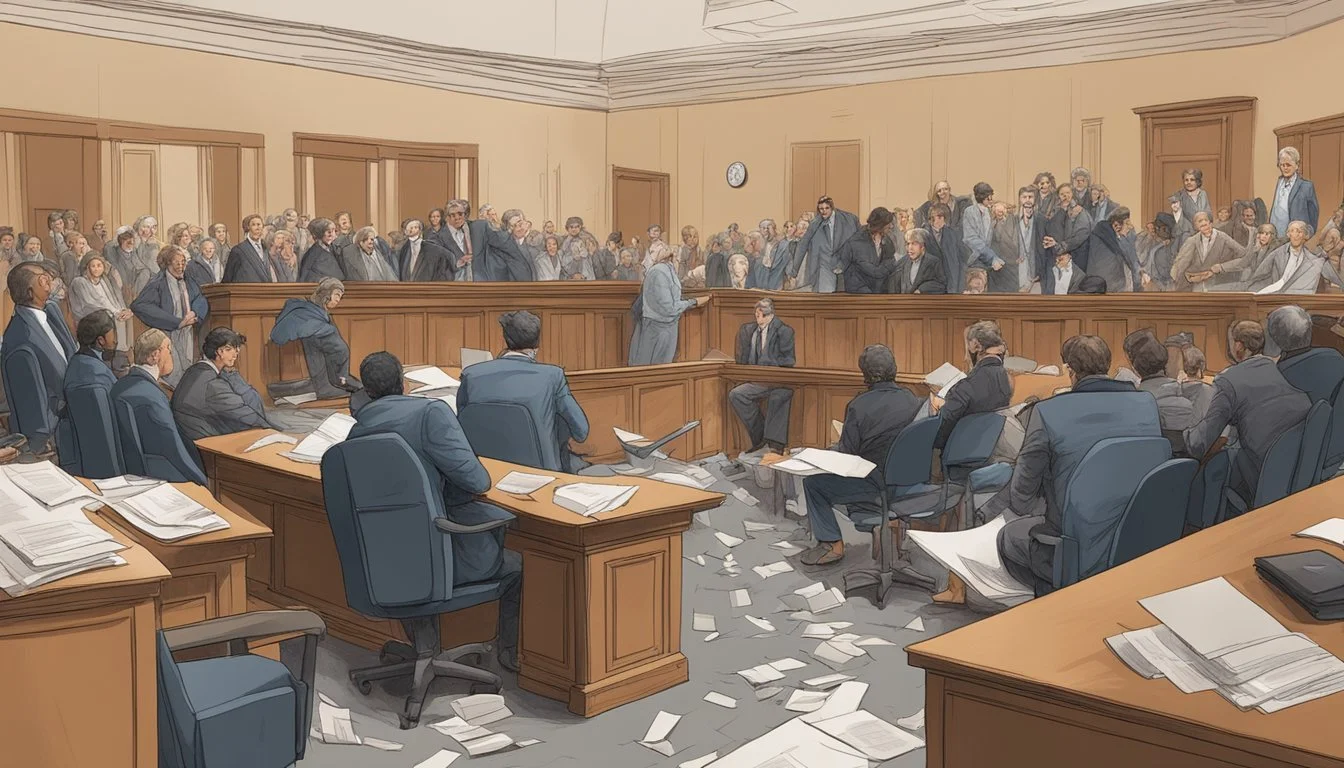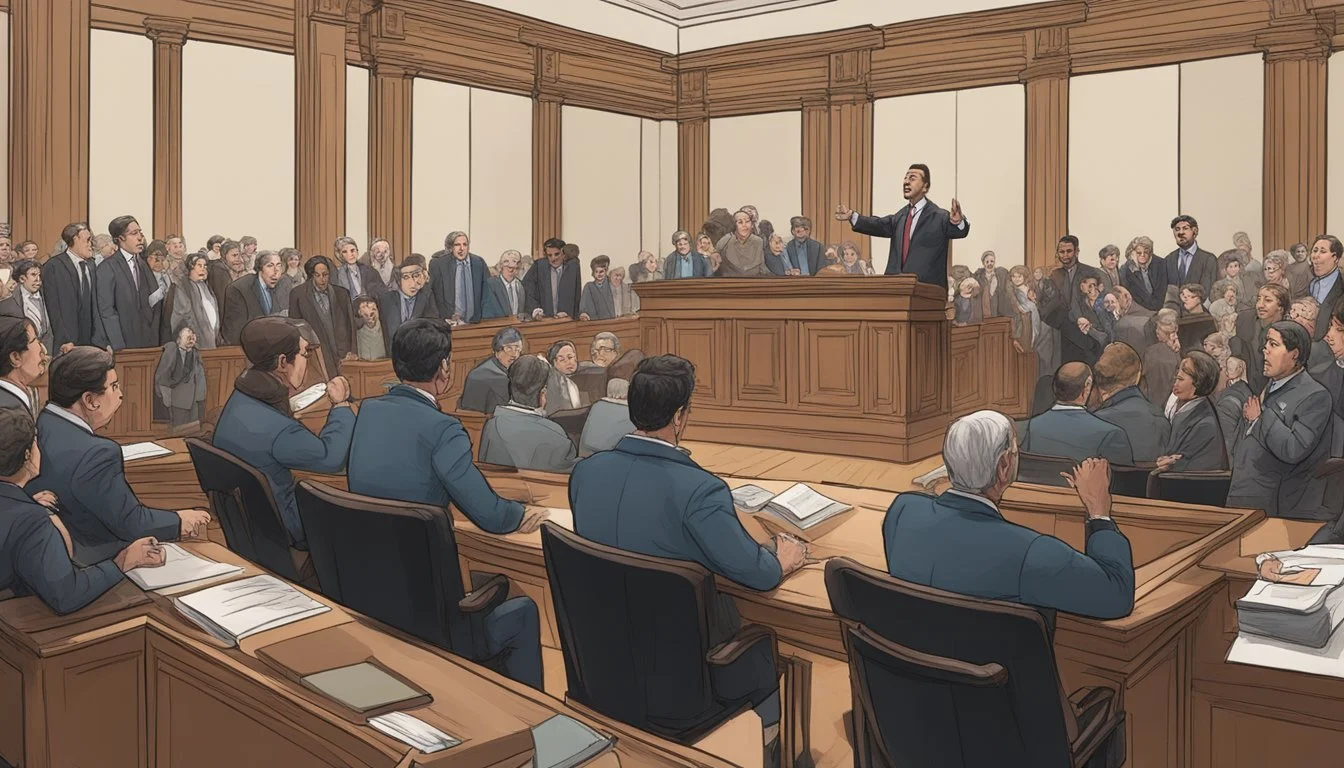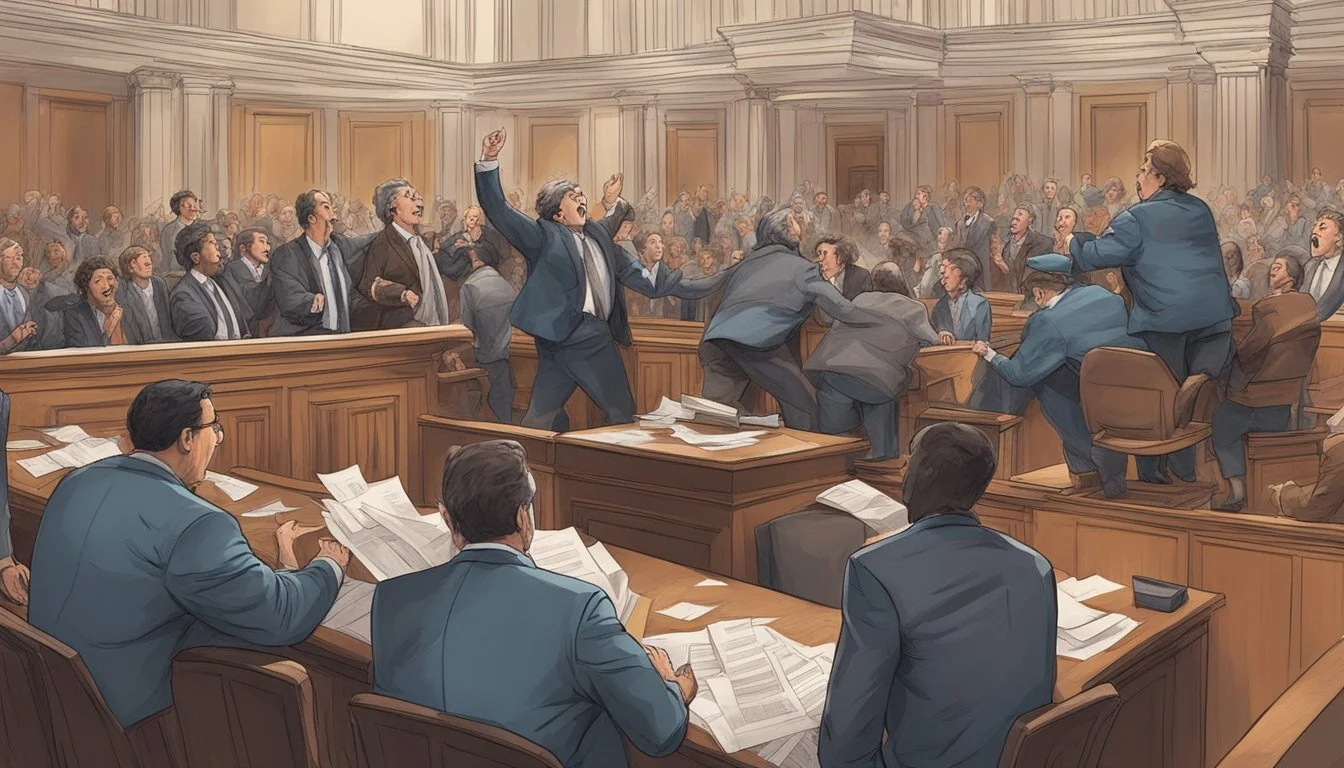Courtroom Chaos: The Actual 'Trial of the Chicago 7'
A Landmark Case in American Legal History
The Trial of the Chicago 7 stands as a landmark legal battle in American history. In 1968, anti-Vietnam War protesters clashed with police during the Democratic National Convention in Chicago. The aftermath led to charges against eight activists for allegedly inciting riots.
The trial, which began in 1969, became a spectacle that captivated the nation and highlighted the deep divisions in American society during that tumultuous era. The courtroom proceedings were marked by heated exchanges, unconventional tactics, and controversial rulings by Judge Julius Hoffman.
The defendants, including well-known figures like Abbie Hoffman and Tom Hayden, used the trial as a platform to voice their opposition to the Vietnam War and challenge the establishment. Their colorful personalities and provocative actions turned the courtroom into a stage for political theater, reflecting the cultural upheaval of the late 1960s.
Historical Context
The Trial of the Chicago 7 unfolded against a backdrop of intense social and political upheaval in the United States. Civil unrest, anti-war sentiment, and demands for racial equality converged in 1968, setting the stage for a landmark legal battle.
1968 Democratic National Convention
The Democratic National Convention in Chicago became a flashpoint for protest and violence. Thousands of demonstrators descended on the city to voice opposition to the Vietnam War and advocate for social change. Mayor Richard Daley mobilized 12,000 police officers and called in thousands of National Guard troops.
Clashes erupted between protesters and law enforcement. Television cameras captured violent confrontations, shocking viewers nationwide. The chaotic scenes outside the convention hall overshadowed the political proceedings inside.
The National Mobilization Committee to End the War in Vietnam played a key role in organizing the demonstrations. Their actions drew both support and criticism from different segments of American society.
Vietnam War Protests
Anti-war sentiment reached a fever pitch in 1968. The Tet Offensive earlier that year had shaken public confidence in the war effort. Draft resistance grew, and peace rallies attracted massive crowds across the country.
Students, veterans, and activists united in their calls to end U.S. involvement in Vietnam. The Chicago protests aimed to pressure Democratic leaders to adopt an anti-war platform.
The demonstrators' tactics ranged from peaceful sit-ins to more confrontational approaches. Their presence in Chicago highlighted the deep divisions within American society over the war.
Civil Rights Movement Impact
The civil rights struggle significantly influenced the events in Chicago. The Civil Rights Act of 1968, passed just months earlier, addressed discrimination in housing but fell short of broader demands for racial justice.
Many protesters saw connections between the fight for civil rights at home and opposition to the war abroad. African American activists played prominent roles in both movements.
The trial itself reflected ongoing tensions around race and political dissent in America. The defendants' diverse backgrounds and ideologies underscored the complex social dynamics of the era.
The Chicago 7 Defined
The Chicago 7 were a group of anti-war activists charged for their roles in protests at the 1968 Democratic National Convention. They became symbols of the counterculture movement and the government's attempts to suppress dissent during a turbulent era.
Profile of the Defendants
The Chicago 7 consisted of Tom Hayden, Abbie Hoffman, Jerry Rubin, Rennie Davis, David Dellinger, Lee Weiner, and John Froines. Hayden was a founder of Students for a Democratic Society. Hoffman and Rubin were leaders of the Youth International Party (Yippies).
Davis was a community organizer. Dellinger was a longtime pacifist activist. Weiner was a teaching assistant at Northwestern University. Froines was a chemistry professor.
Originally, the group was the Chicago 8, including Black Panther Party co-founder Bobby Seale. His case was later separated from the others.
Charges and Allegations
The defendants faced charges of conspiracy to cross state lines with intent to incite a riot. They were accused of planning violent demonstrations at the 1968 Democratic National Convention in Chicago.
Prosecutors alleged the group orchestrated confrontations with police and encouraged property destruction. The defendants maintained the charges were politically motivated attempts to suppress anti-war activism.
The trial became a spectacle, with the defendants often mocking court proceedings. Judge Julius Hoffman's strict courtroom control led to numerous contempt charges against the defendants and their lawyers.
Yippies and the Youth International Party
The Youth International Party, known as the Yippies, was founded by Abbie Hoffman and Jerry Rubin in 1967. It blended countercultural ideals with theatrical protest tactics.
Yippies used humor and spectacle to draw attention to their anti-war message. They staged events like attempting to levitate the Pentagon and nominating a pig for president.
At the 1968 Democratic Convention, Yippies organized protests and street theater. Their provocative style clashed with Chicago authorities, contributing to the chaotic scenes that unfolded during the convention.
Key Events Leading to the Trial
The Chicago Seven trial stemmed from a series of chaotic events in August 1968. Tensions escalated between anti-war protesters and police, culminating in violent clashes that shocked the nation.
Protests and Police Response
Anti-Vietnam War demonstrations intensified in Chicago during the 1968 Democratic National Convention. Thousands of protesters converged on the city, determined to voice their opposition to the war. Mayor Richard Daley mobilized a massive police force to maintain order.
The atmosphere was tense from the start. Police enforced strict curfews and dispersal orders. Protesters defied these restrictions, staging sit-ins and marches throughout downtown Chicago. Clashes between demonstrators and law enforcement became increasingly frequent and aggressive.
The Events at Grant Park
On August 28, a pivotal confrontation occurred in Grant Park. Protesters attempted to march to the convention site but were blocked by police. A standoff ensued near a statue of General John Logan.
When demonstrators tried to lower the American flag, police charged into the crowd. They used batons and tear gas to disperse the protesters. Many demonstrators were beaten and arrested. The violence in Grant Park marked a turning point in the week's events.
Night of Violence and the Police Riot
The situation reached a boiling point on August 28-29, in what became known as the "Battle of Michigan Avenue." Protesters gathered outside the Conrad Hilton Hotel, where many convention delegates were staying.
Police attacked the crowd with tear gas and clubs. Demonstrators responded by throwing rocks and bottles. The violence spilled onto the streets and into nearby parks. Journalists and bystanders were caught in the chaos.
Many observers described the police response as a "police riot." Television cameras captured shocking images of brutality. The events of that night left a lasting impact on American politics and public opinion about the Vietnam War.
The Trial
The trial of the Chicago 7 was marked by tumultuous courtroom proceedings, controversial rulings, and heated confrontations between the defendants, their lawyers, and the judge. It highlighted deep political and generational divides in American society during the late 1960s.
Courtroom Participants and Legal Teams
The defendants included prominent anti-war activists Abbie Hoffman, Jerry Rubin, David Dellinger, Tom Hayden, Rennie Davis, John Froines, and Lee Weiner. Bobby Seale, co-founder of the Black Panther Party, was initially the eighth defendant.
The prosecution team was led by U.S. Attorney Thomas Foran and Assistant U.S. Attorney Richard Schultz. They argued that the defendants had conspired to incite riots during the 1968 Democratic National Convention in Chicago.
William Kunstler and Leonard Weinglass served as the primary defense attorneys. Their strategy focused on portraying the trial as politically motivated and highlighting police brutality during the protests.
Judge Julius Hoffman's Courtroom
Judge Julius Hoffman presided over the trial, which began on September 24, 1969. His strict courtroom management and perceived bias against the defendants became a central point of controversy.
Hoffman frequently clashed with the defendants and their attorneys. He denied numerous defense motions and objections, often ruling in favor of the prosecution.
The judge's demeanor and decisions led to accusations of unfairness and judicial misconduct. This tension contributed to the chaotic atmosphere that characterized much of the trial.
Contempt of Court and Bobby Seale
Bobby Seale's treatment in court became a flashpoint in the trial. After his lawyer fell ill, Seale requested to represent himself or have the trial delayed. Judge Hoffman denied these requests.
When Seale protested, Hoffman ordered him bound and gagged in the courtroom. This shocking spectacle lasted for several days before Seale's case was declared a mistrial.
The judge cited Seale for 16 counts of contempt of court. This incident heightened tensions and further eroded trust in the judicial process among the defendants and their supporters.
Testimonies and Counterarguments
The trial featured a parade of high-profile witnesses, including folk singer Arlo Guthrie, writer Norman Mailer, and countercultural icon Allen Ginsberg. Their testimonies often veered into theatrical territory, matching the unconventional nature of the proceedings.
A key moment came when former Attorney General Ramsey Clark attempted to testify. Judge Hoffman barred his testimony, which would have supported the defense's argument that the charges were politically motivated.
The defendants used their time on the stand to criticize the Vietnam War and advocate for social change. This approach often led to heated exchanges with the prosecution and further contempt citations from Judge Hoffman.
Media and Public Perception
The trial of the Chicago Seven garnered intense media coverage and shaped public opinion both domestically and internationally. Newspapers, television, and radio played crucial roles in informing the public about the courtroom proceedings and the broader social issues at stake.
Role of Media During the Trial
Major newspapers like The New York Times and Chicago Tribune provided daily coverage of the trial. Television networks aired nightly updates, bringing the courtroom drama into American living rooms. Reporters highlighted the confrontational exchanges between Judge Julius Hoffman and the defendants, particularly the treatment of Bobby Seale.
The media's presence amplified the theatrical nature of the proceedings. Defendants like Abbie Hoffman and Jerry Rubin used press conferences and interviews to promote their political messages. Their colorful antics and provocative statements often overshadowed the legal arguments, frustrating prosecutors.
Journalists faced challenges in maintaining objectivity while reporting on such a politically charged case. Some outlets were criticized for sensationalism, while others were praised for in-depth analysis of the constitutional issues at play.
Influence on Public Opinion
Media coverage of the trial significantly impacted public perception of the anti-war movement and government authority. Many Americans formed strong opinions based on what they saw and read.
Supporters of the defendants viewed the trial as:
A political witch hunt
An attack on free speech
Evidence of government overreach
Critics saw it as:
Necessary law enforcement
A defense of public order
Punishment for violent protesters
The defendants' courtroom behavior and Judge Hoffman's strict rulings polarized public opinion further. Young people and liberals tended to sympathize with the Chicago Seven, while conservatives often backed the prosecution.
Media portrayals of the trial influenced broader debates about:
The Vietnam War
Civil rights
The counterculture movement
Law enforcement tactics
International Attention
The trial of the Chicago Seven attracted significant international media coverage. Foreign journalists flocked to the Chicago courtroom, recognizing the global implications of the case.
European newspapers often framed the trial as a test of American democracy and free speech. Many expressed concern about the treatment of protesters and questioned the fairness of the proceedings.
In countries experiencing their own student protests, like France and West Germany, the trial resonated strongly. Activists drew parallels between their struggles and those of the Chicago Seven.
Soviet and Chinese state media used the trial to criticize American society, portraying it as evidence of repression and social unrest in the capitalist system.
The international spotlight added pressure on the U.S. government and amplified the trial's significance as a symbol of 1960s political and cultural upheaval.
Cultural Impact
The Trial of the Chicago 7 left an indelible mark on American society, influencing activism, art, and political discourse for decades to come. Its themes of dissent and justice continue to resonate with modern social movements.
Long-term Effects on Activism
The trial galvanized anti-Vietnam War activists and inspired a new generation of protesters. It highlighted the power of civil disobedience and media attention in challenging authority. Many activists adopted tactics used by the Chicago 7, such as theatrical courtroom behavior and leveraging public opinion.
The defendants' bold stance against what they viewed as an unjust system became a blueprint for future movements. Their ability to turn a trial into a political platform demonstrated the effectiveness of using legal proceedings to amplify activist messages.
This approach influenced environmental, civil rights, and anti-globalization movements in subsequent decades. The trial's legacy encouraged activists to confront systemic issues head-on, even at personal risk.
Reflection in Arts and Literature
The Chicago 7 trial captured the imagination of artists and writers. Authors like Norman Mailer and Allen Ginsberg incorporated elements of the trial into their work, reflecting its cultural significance.
Films, plays, and documentaries have retold the story, each offering new perspectives on the events. These artistic interpretations have kept the trial's memory alive, introducing it to new generations.
Music of the era often referenced the trial, with protest songs becoming anthems for the anti-war movement. Visual artists created posters and artwork depicting the defendants, which became iconic symbols of 1960s counterculture.
Comparisons to Modern Events
Recent protests, such as those led by Black Lives Matter following the deaths of George Floyd and Breonna Taylor, draw parallels to the Chicago 7 era. Both periods saw widespread civil unrest and debates over the role of law enforcement in society.
Modern protest leaders often cite the Chicago 7 as inspiration, adopting similar strategies of media engagement and civil disobedience. The use of social media in contemporary movements echoes the Chicago 7's savvy manipulation of press coverage.
Critics and supporters alike draw comparisons between the government's response to 1960s protests and current approaches to dissent. These parallels spark discussions about the evolution of protest rights and state power in the United States.
Representation in Media
The Trial of the Chicago 7 has inspired multiple creative works, bringing this historical event to wider audiences through theater and film. These adaptations have sought to capture the drama and significance of the trial.
Theatrical Adaptations
"The Chicago Conspiracy Trial" premiered on Broadway in 1979, dramatizing key moments from the courtroom proceedings. The play used actual trial transcripts to recreate the charged atmosphere and confrontations between defendants and Judge Julius Hoffman. In 1994, another stage production called "Conspiracy: The Trial of the Chicago 8" debuted, offering a fresh take on the events. These theatrical works helped keep the story alive in popular culture, introducing new generations to this pivotal moment in American history.
Aaron Sorkin's Netflix Film
In 2020, acclaimed writer-director Aaron Sorkin brought "The Trial of the Chicago 7" to Netflix. The film featured a star-studded cast, including Sacha Baron Cohen as Abbie Hoffman and Frank Langella as Judge Julius Hoffman. Sorkin's adaptation aimed to balance historical accuracy with dramatic storytelling, condensing the five-month trial into a two-hour runtime. The movie received critical acclaim for its performances and relevance to contemporary social issues.
While taking some creative liberties, the film stayed true to many key events and dialogue from the actual trial. It highlighted the political tensions of the era and the clash between anti-war protesters and the government. The Netflix release introduced the Chicago Seven's story to a global streaming audience, renewing interest in this significant chapter of American legal and cultural history.




